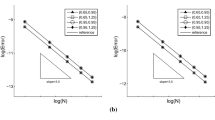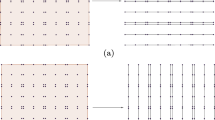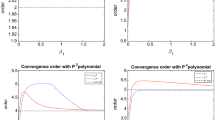Abstract
The direct discontinuous Galerkin (DDG) finite element method, using piecewise polynomials of degree k ≥ 1 on a Shishkin mesh, is applied to convection-dominated singularly perturbed two-point boundary value problems. Consistency, stability and convergence of order k (up to a logarithmic factor) are proved in an energy-type norm appropriate to the method and problem. The results are robust, i.e., they hold uniformly for all values of the singular perturbation parameter. Numerical experiments confirm the theoretical convergence rate.


Similar content being viewed by others
References
Brenner, S.C., Ridgway Scott, L.: The Mathematical Theory of Finite Element Methods, Volume 15 of Texts in Applied Mathematics, 3rd edn. Springer, New York (2008)
Cao, W., Liu, H., Zhang, Z.: Superconvergence of the direct discontinuous Galerkin method for convection-diffusion equations. Numer Methods Partial Diff. Equ. 33(1), 290–317 (2017)
Ciarlet, P.G.: The Finite Element Method for Elliptic Problems, Volume 40 of Classics in Applied Mathematics. Society for Industrial and Applied Mathematics (SIAM), Philadelphia (2002). Reprint of the 1978 original [North-Holland, Amsterdam; MR0520174 (58 #25001)]
Clavero, C., Gracia, J.L., O’Riordan, E.: A parameter robust numerical method for a two dimensional reaction-diffusion problem. Math. Comp. 74(252), 1743–1758 (2005)
Di Pietro, D.A., Ern, A.: Mathematical Aspects of Discontinuous Galerkin Methods, Volume 69 of Mathématiques & Applications (Berlin) [Mathematics & Applications]. Springer, Heidelberg (2012)
Liu, H., Yan, J.: The direct discontinuous Galerkin (DDG) methods for diffusion problems. SIAM J. Numer. Anal. 47(1), 675–698 (2008/09)
Liu, H., Yan, J.: The direct discontinuous Galerkin (DDG) method for diffusion with interface corrections. Commun. Comput. Phys. 8(3), 541–564 (2010)
Meng, X., Shu, C.-W., Wu, B.: Optimal error estimates for discontinuous Galerkin methods based on upwind-biased fluxes for linear hyperbolic equations. Math. Comp. 85(299), 1225–1261 (2016)
Nhan, T.A., Stynes, M., Vulanović, R.: Optimal uniform-convergence results for convection-diffusion problems in one dimension using preconditioning. J. Comput. Appl Math. 338, 227–238 (2018)
Roos, H.-G., Stynes, M., Tobiska, L.: Robust Numerical Methods for Singularly Perturbed Differential Equations, Volume 24 of Springer Series in Computational Mathematics, 2nd edn. Springer, Berlin (2008). Convection-diffusion-reaction and flow problems
Shen, J., Tang, T., Wang, L.-L.: Spectral Methods, Volume 41 of Springer Series in Computational Mathematics. Springer, Heidelberg (2011). Algorithms, analysis and applications
Shishkin, G.I.: Grid approximation of singularly perturbed systems of elliptic and parabolic equations with convective terms. Differ. Uravn. 34(12), 1686–1696, 1727 (1998)
Stynes, M., Stynes, D.: Convection-Diffusion Problems: An Introduction to Their Analysis and Numerical Solution, Volume 196 of Graduate Studies In Mathematics. American Mathematical Society, Providence (2018)
Stynes, M., Tobiska, L.: The SDFEM for a convection-diffusion problem with a boundary layer: Optimal error analysis and enhancement of accuracy. SIAM J. Numer. Anal. 41(5), 1620–1642 (2003)
Funding
The research of Martin Stynes is supported in part by the National Natural Science Foundation of China under grant NSAF-U1530401.
Author information
Authors and Affiliations
Corresponding author
Additional information
Publisher’s note
Springer Nature remains neutral with regard to jurisdictional claims in published maps and institutional affiliations.
Appendices
Appendix 1
In this Appendix, we collect some standard results from finite element analysis. The three lemmas that follow are valid under the hypotheses stated for each lemma (i.e., they are not specifically for Shishkin meshes).
Lemma 10 (inverse inequality)
[1, Lemma 4.5.3]. LetD ⊂ [0, 1] be partitioned by a quasiuniform mesh of diameter d and\(\mathbb {V}\)bea finite-dimensional subspace of\({W^{l}_{p}}(D)\cap {W^{m}_{q}}(D)\), where 1 ≤ p ≤∞,1 ≤ q ≤∞and 0 ≤ l ≤ m. Then, there exists a constant C such that forall\(v\in \mathbb {V}\), one has
Lemma 11 (Bramble-Hilbert lemma)
[3, Theorem 4.1.3] Suppose\(D \subset \mathbb {R}\)isan interval. For non-negative integer kand 0 ≤ q ≤∞, let L be a continuous linear functional on the Sobolev spaceWk+ 1, q(D) with the property thatL(w) = 0 for all\(w\in \mathbb {P}_{k}(D)\). Then, there is a constantC(D) such that
where\(\|L\|{~}_{k+1,q,D}^{*}\)is the norm inthe dual space ofWk+ 1, q(D).
Lemma 12
[3, Theorem 3.1.2] Let D and\(\overline {D}\)betwo subintervals of\(\mathbb {R}\). Let\( F:\overline {D} \to D\)bean invertible affine mapping defined by\(F(\overline {x})=B \overline {x}+b\)with\(D = F(\overline {D})\). Letv ∈ Wm, p(D) for some integerm ≥ 0 and somep ∈ [1, ∞]. Then, the function\(\overline {v} = v\circ F \in W^{m,p}(\overline {D})\)and\(|\overline {v}|{~}_{m,p,\overline {D}}\lesssim |B|{~}^{m-1/p} |v|{~}_{m,p,D}\)forallv ∈ Wm, p(D). Analogously, one has\(|v|{~}_{m,p,D} \lesssim |B|{~}^{-m+1/p} |\overline {v}|{~}_{m,p,\overline {D}}\)forall\(\overline {v}\in W^{m,p}(\overline {D})\).
Appendix 2
1.1 Proof of Lemma 5
We prove this lemma for an arbitrary general mesh. The interval Ij is affine equivalent to ω := [− 1, 1] through the linear mapping
For m = 0, 1,..., let Lm be the mth Legendre polynomial on the interval [− 1, 1] (see [11, Chapter 3.3] for the properties of Legendre polynomials). Let Lj, m be Lm mapped to the interval Ij, i.e., \(L_{j,m}(x)=L_{m}(\overline {x})\). Each function w ∈ L2(Ij) can be expanded as a sum of Legendre polynomials: \(w={\sum }_{j=0}^{\infty }w_{j,m}L_{j,m}\), where
Furthermore, the L2(Ω) projection defined in (17) can be expressed as
Then, the mapped projection is
It follows that for any polynomial \(v\in \mathbb {P}^{k}(\omega )\), one has \(\overline {P}v=v\).
By Lemma 12, we have
But Lemma 11 gives
where \(C\|\overline {P}- I\|{~}_{k+1,q,\omega }^{*}\) is a constant independent of \(\overline {w}\). Using these results and again invoking Lemma 12, we get
Hence, taking p = q = 2, we get (18b) for m ≤ k + 1; taking p = ∞ and q = 2, we get (18c) for m ≤ k + 1.
Finally, to prove (18a), by (18b), we have
1.2 Proof of Lemma 6
The next inequality, which follows from (14), will be used frequently:
From (13), (16), (22), and Lemma 5, for ℓ ∈ {0, 1}, one has
By (18a) and (22), for ℓ ∈ {0, 1}, one has
Using (13) and Lemma 5, for ℓ ∈ {0, 1}, we get
and
Note that \(\|Pu-u\|{~}_{\ell ,I_{j}}\lesssim \|PE-E\|{~}_{\ell ,I_{j}}+\|PS-S\|{~}_{\ell ,I_{j}}\). Then by (23)–(26), for ℓ ∈ {0, 1}, one has
and
This completes the proof.
1.3 Proof of Lemma 7
For m ∈ {0, 1, 2}, Lemma 5 gives (cf. proof of (23) above)
We have now proved (20a), (20b), and (20c).
Next, by the inverse inequality of Lemma 10 and (24), one has
Finally, (13) yields
This completes the proof.
1.4 Proof of Lemma 6
By Lemma 7 with m = 0, since σ = k + 1, we obtain
But
Thus, Lemma 7 (with σ = k + 1) and (27) give
and
Hence,
This inequality and Lemma 6 (with σ = k + 1) yield finally
1.5 Proof of Lemma 9
The definition (5) gives \(\widehat {(Pu-u)}|{~}_{i} = (Pu-u)^{\prime }(x_{i})\) for i ∈ {0, N} and
for j = 1, 2,…, N − 1. Now, two Cauchy-Schwarz inequalities show that
We shall estimate the various terms in (29).
Lemma 6 yields
From Lemma 7 and σ = k + 1, one obtains
As E″∈ C[0, 1], we see that
where we used Lemma 7 and σ = k + 1. Turning now to the contributions of the smooth component S of u to (29), by Lemma 7, one has
Finally, an inverse inequality (Lemma 10) yields
Substituting (30)–(34) into (29), for all vh ∈ Vh, we get
Hence,
where we applied a Cauchy-Schwarz inequality to the integral terms then invoked Lemma 6.
Next, by (4b), we have
for all vh ∈ Vh. Here, a Cauchy-Schwarz inequality gives
by Lemma 6 and the inverse inequality \(H^{2}| v_{h} |{~}^{2}_{1,I_{j}}\lesssim \|v_{h}\|{~}^{2}_{0,I_{j}}\) for j > N/2 (Lemma 10). The other term in Bh(u − Pu, vh) is bounded by
where we used Lemma 7 and the triangle inequality of (28) to estimate the Pu − u terms, while \({\sum }_{N/2+1}^{N}h_{j}^{}[v_{h}]^{2}_{j} \lesssim \|v_{h}\|{~}_{0}^{2}\) follows from the inverse inequality of Lemma 10. Adding (35) and (36), one gets
Finally, Lemma 6 gives
This completes the proof of Lemma 9.
Rights and permissions
About this article
Cite this article
Ma, G., Stynes, M. A direct discontinuous Galerkin finite element method for convection-dominated two-point boundary value problems. Numer Algor 83, 741–765 (2020). https://doi.org/10.1007/s11075-019-00701-1
Received:
Accepted:
Published:
Issue Date:
DOI: https://doi.org/10.1007/s11075-019-00701-1




